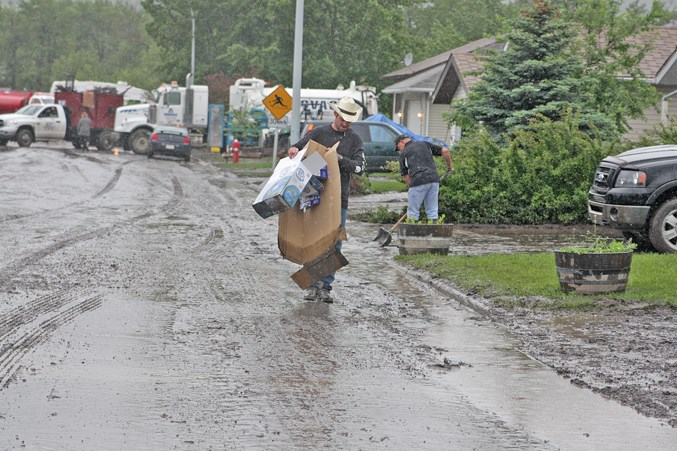Ruth and Gary Reid get a little nervous every June, keeping their eyes on the nearby river and their fingers crossed. It was five years ago that the Black Diamond couple lost tens of thousands of dollars worth of belongings when water from the Sheep River flooded their basement, main level, garage and yard on June 20, 2013. The southern Alberta flood was deemed the second costliest disaster in Canadian history, estimated at $1.72 billion in insured damage. “When it rains we go check the river all the time,” said Ruth. “That paranoia doesn’t go away.” Ruth and her grown daughter, Elaina, suffered nightmares for months after the flood. Gary was impacted in a different way. He was in Dubai when the flood hit so he was unable to help his family. “I felt I came close to losing a wife and a daughter,” he said. “I still get emotional when I think about it. I stay home in June now.” The couple lives on First Avenue, just two blocks from a bend in the Sheep River. Ruth describes the details of that day as if it just happened yesterday, recalling the phone call from her sister-in-law informing her about the flood and then walking to the nearby grocery store to collect the newspaper. It was about 7 a.m. “The AG Foods parking lot had a whole bunch of water in it,” she said. “I walked to the boulevard and the water was rushing down the street.” A man in a truck gave Ruth a ride back home. Shortly after, a firefighter knocked on her door and told her to move her vehicle to higher ground. After doing so, Ruth returned home to remove items from her garage as it filled with water. “The next thing I know my daughter bursts through the door with a firefighter,” said Reid. “She said, ‘Grab the cat. We’ve got five minutes.’ We grabbed the cat and a couple of things and we were out the door.” It was three days before Ruth returned home to remove the mud, silt and countless items ruined in the flood with help from family, friends and neighbours. “We had over a metre of water run through the basement and two feet of water in the garage, so anything that was on the floor was ruined,” she said. Among the items they lost was mohair blankets from Scotland, antique trunks, tailor made suits, furniture, furnace, water heater, vacuum system, soft water system, yard landscaping, hot tub, deep freeze full of food and the backyard shed and its contents. Their daughter lost all of her belongings in her basement bedroom. “It hurts but our house is still standing,” said Ruth. “It’s still a nice spot and we still have great neighbours.” The Reids received about $29,000 from the Province, more than $5,000 from the Canadian Red Cross and $53,000 from insurance. About $110,000 came from out of pocket to repair the damage. “You never get reimbursed fully,” Ruth said. “We are just grateful that we did get something from the government and insurance company and the Red Cross.” The Reids then protected their home to government standards so if another flood hits there will be minimal damage. “We mitigated everything to government standards, otherwise we’re not covered if it happens again,” Ruth said. “We are all wiser and smarter and more prepared.” On the other side of Highway 22, along the Sheep River, the Bob Lochhead Memorial Campground is thriving despite almost being wiped out by the flood five years ago. “It took a little while to straighten a few of the things out that were done in the campground but it’s all proceeding nicely now,” said campground chairman James Lee. “We certainly don’t have any trouble filling it.” Lee was there when the campers were evacuated early that Thursday morning. “I shed tears that day knowing that this was what we’re going to be left with, but also knowing what was down-river headed to other communities,” he said. “I knew that it was going to take a monumental effort by a great number of people to pull it off. We didn’t even know for the first couple of weeks whether we would ever be open again.” The campground, owned by the Town and operated by the Foothills Lions Club, lost land, buildings, trees, picnic tables and fire pits when the river swept through it. Residents pulled together to bring the campground back with help from local contractors, Foothills Lions Club volunteers, the Town of Black Diamond and even Oilfields High School students, who built picnic tables and fire pits, and placed sod on the berm built to protect the campground. Other improvements have included planting 50 trees, with another 20 slated for this fall, updating the electrical system, replacing lights with LED versions, adding water barrels to water the gardens and installing a hot water on demand system in the bathrooms. The campground received about $165,000 in insurance money and the Province allocated $1.132 million through the Disaster Recovery Program. For two years, the campground opened for part of the season with less than half of the original 64 sites while the north sites remained under construction. It now consists of 52 full service sites. “It’s been a good experience to see it come back like that because it takes away the hurt that we felt initially,” said Lee. “There’s been a lot of work and great dedication shown by the Foothills Lions Club in putting things back right and trying to make them better than ever. The Lions are grateful for their community and for the support we got in putting the wheels back on to make this happen.”




